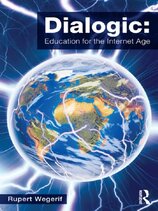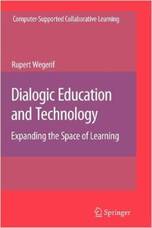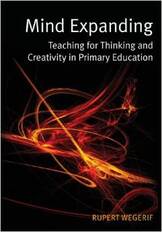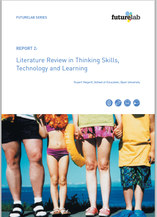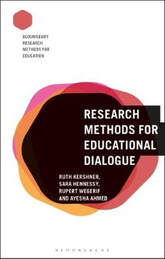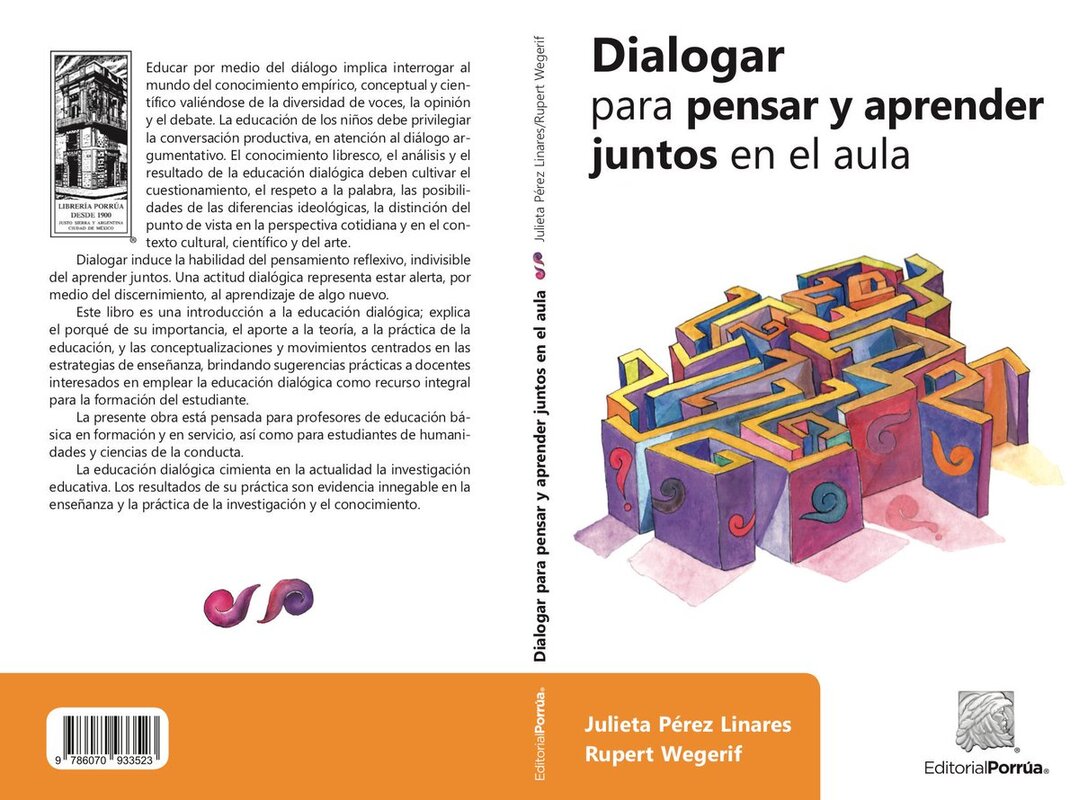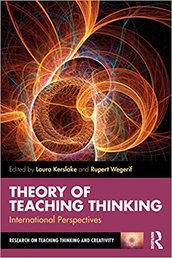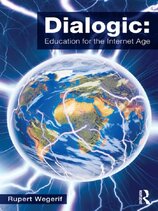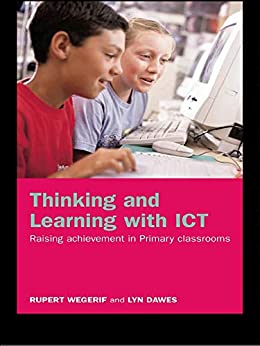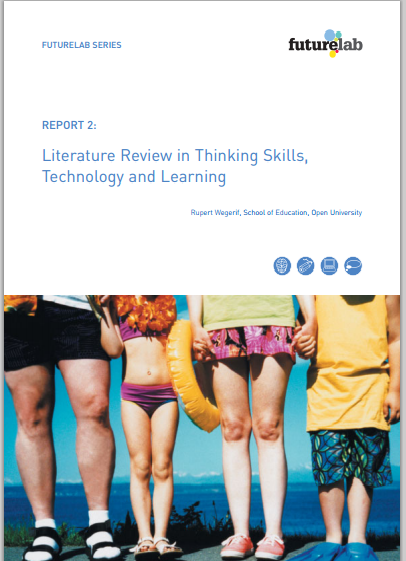Books: free preprint downloads
Books: latest first
The theory of Educational Technology: Towards a dialogic foundation for design - out December 2023. Routledge.
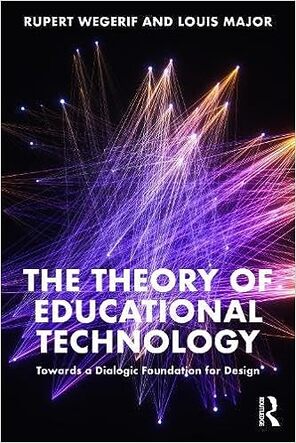
Educational technology is controversial – some see it as essential to providing free global learning, others view it as a dangerous distraction that undermines good education. In both instances, most theories that have previously been applied to educational technology do not account for the distinctive nature and vast potential of technology. This book addresses this issue, exploring how education has been bound up with technology from the beginning, and recognising that educational aims have already been shaped by technologies. Offering a ‘dialogic’ theory of educational technology, Rupert Wegerif and Louis Major respond to contemporary challenges to education within this book, including, but not limited to, climate change, misinformation on the internet and the impact of Artificial Intelligence.
Chapters introduce, discuss, and contextualise key theories and illustrate through case studies their uses within a diverse range of educational contexts, spanning from primary education to adult lifelong learning. Each chapter also concludes with a short summary, demonstrating how these theories translate to practical implications for design.
A fascinating response to current developments in educational technology, this is a crucial read for all involved in creating, researching or making decisions about the use of technologies within educational contexts.
Chapters introduce, discuss, and contextualise key theories and illustrate through case studies their uses within a diverse range of educational contexts, spanning from primary education to adult lifelong learning. Each chapter also concludes with a short summary, demonstrating how these theories translate to practical implications for design.
A fascinating response to current developments in educational technology, this is a crucial read for all involved in creating, researching or making decisions about the use of technologies within educational contexts.
Early reviews of The Theory of Educational Technology
The book is an ambitious development of a theory of educational technology from historical, philosophical, psychological, and pedagogical perspectives. It is important for the EdTech community to have this challenge to our thinking, as the concept itself grows ever more complex. The authors argue from a strong foundational base of thinking through and enriching the idea of ‘dialogic education’. It will inform a deeper debate around the newly perceived roles and impact of AI.
Diana Laurillard, Professor of Learning with Digital Technology, UCL.
It’s sometimes said that pioneers in educational technology have no time for history and no use for theory. Setting cynicism aside, it remains true that connecting theory and practice in educational technology is difficult work, just as it is in education. Here’s the heart of this book’s argument: it is necessary to reframe the relations between technology and education, in theory and practice. Technology is not an adjunct to education. It precedes and gives purpose to education. It always has. Wegerif and Major succeed in opening a dialogic space within which we can collectively reshape relations between tools and goals, ideas and actions. This is a timely and important contribution.
Peter Goodyear, Emeritus Professor of Education, The University of Sydney, Australia
In this volume, Wegerif and Major provide an inspired and innovative vision for understanding the role of technology in education. Written in an accessible way for wide readership, the authors harness “a new dialogic theory of educational technology” that both informs and benefits from the examples of pedagogical practice they provide. The result is a powerful set of insights into how new technologies affect both the individual and social dimensions of pedagogical practice. Their dialogic approach is perhaps the best way we have to date to generate these insights, and there are probably no other authors who could outline the practical applications so well. This volume promises to have major implications for several disciplines.
James Wertsch, Department of Anthropology, Washington University in St. Louis.
This inspiring book puts dialogue at the heart of a new technology-enhanced education. Combining the rich history of educational technology with illuminating case studies and philosophical depth, it makes a compelling case for a science of educational design that connects learners in creating meaning across cultures, spaces and times. The Theory of Educational Technology is deeply researched, lucid and optimistic. It offers educators, technologists, researchers and policy makers a shared foundation to build education for a digital future.
Mike Sharples, Emeritus Professor of Educational Technology, Institute of Educational Technology
In a world of pandemics, social media, Internet information access and ChatGPT, schools hastily adopt online technologies. However, prevailing thinking about educational technology is steeped in outmoded perspectives. Sophisticated recent theories of dialogic learning and technology adaptation open new opportunities for educational approaches that avoid the perils of inappropriate technological tools. These new theories are based on sophisticated philosophical developments of the past hundred years, many of which are difficult to comprehend. Fortunately, this book reviews and considers deeply the most important innovative theories, pedagogies and technologies – and their philosophical bases – in an eminently readable, insightful, critical and coherent presentation.
Gerry Stahl, Professor Emeritus of Information and Computer Science, Drexel University, USA, and Founding Editor, International Journal of Computer-Supported Collaborative Learning
Educational science can be considered a design science, concerned with two questions: What should people learn and teach? And how can we assist people in pursuing such educational goals? This insightful book addresses these key questions with a focus on the design of educational technology. The dialogue between the concrete cases and theoretical framing shows how technology can be put to work in our endeavours to engage, support and connect students, and expand their horizons. The book is unique in combining philosophical depth with convincing examples.
Arthur Bakker, Professor of STEM Education and Curriculum at the University of Amsterdam, the Netherlands
Research Methods for Educational Dialogue
|
Research Methods for Educational Dialogue provides an overview of the range of possibilities for researching various forms of educational dialogue, underpinned by a coherent theoretical foundation. The authors, Kershner, Hennessy, Wegerif and Ahmed offer an integrated understanding of different methodological approaches in this fast-growing area of education. The book includes critical discussion of a variety of methods for investigating the characteristics and quality of dialogues for individuals and groups of participants in different educational contexts. These include student-student, teacher-student and wider professional dialogues, conducted face-to-face, online or mediated by classroom technologies. The authors argue for the integration of ethical and methodological principles, and consider the potential for innovative research methods that are dialogic in themselves.
Including chapter commentaries from invited experts in the field, authentic research examples and a glossary of terms, this is essential reading for anyone looking to research in the area of educational dialogue. |
Contents
1. Introduction
2. Foundations for Research on Educational Dialogue
3. Orientations and Ground Rules: A Framework for Researching Educational Dialogue, Rupert Wegerif, with commentary by Antonia Larrain
4. Methodological Developments in Research on Educational Dialogue: Mapping the Field
5. Dialogic Participation and Outcomes: Evaluation and Assessment, Ayesha Ahmed, with commentary by Gordon Stobart
6. Analytical Coding Schemes for Classroom Dialogue, Sara Hennessy, with commentary by Adam Lefstein and Matan Barak
7. Methods for Researching Technology-Mediated Dialogue, Sara Hennessy, with commentary by Manoli Pifarré Turmo
8. Researching Online Dialogues: Introducing the 'Chiasm' Methodology, Rupert Wegerif, with commentary by M. Beatrice Ligorio
9. Dialogue, Participation and Social Relationships, Ruth Kershner, with commentary by Antti Rajala
10. Researching Dialogue in Educational Decision Making, Ruth Kershner, with commentary by Sherice Clarke
11. Dialogic Forms of Research Engagement, Reporting and Dissemination, Ruth Kershner, Sara Hennessy and Ayesha Ahmed, with commentary by Christine Edwards-Groves
12. Concluding Remarks
1. Introduction
2. Foundations for Research on Educational Dialogue
3. Orientations and Ground Rules: A Framework for Researching Educational Dialogue, Rupert Wegerif, with commentary by Antonia Larrain
4. Methodological Developments in Research on Educational Dialogue: Mapping the Field
5. Dialogic Participation and Outcomes: Evaluation and Assessment, Ayesha Ahmed, with commentary by Gordon Stobart
6. Analytical Coding Schemes for Classroom Dialogue, Sara Hennessy, with commentary by Adam Lefstein and Matan Barak
7. Methods for Researching Technology-Mediated Dialogue, Sara Hennessy, with commentary by Manoli Pifarré Turmo
8. Researching Online Dialogues: Introducing the 'Chiasm' Methodology, Rupert Wegerif, with commentary by M. Beatrice Ligorio
9. Dialogue, Participation and Social Relationships, Ruth Kershner, with commentary by Antti Rajala
10. Researching Dialogue in Educational Decision Making, Ruth Kershner, with commentary by Sherice Clarke
11. Dialogic Forms of Research Engagement, Reporting and Dissemination, Ruth Kershner, Sara Hennessy and Ayesha Ahmed, with commentary by Christine Edwards-Groves
12. Concluding Remarks
The Routledge International Handbook of Research on Dialogic Education
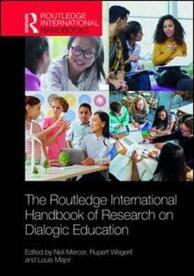
Mercer, N., Wegerif, R., & Major, L. (2019). The Routledge International Handbook of Research on Dialogic Education.
The Routledge International Handbook of Research on Dialogic Education provides a comprehensive overview of the main ideas and themes that make up the exciting and diverse field of Dialogic Education. With contributions from the world’s leading researchers, it describes underpinning theoretical approaches, debates, methodologies, evidence of impact, how Dialogic Education relates to different areas of the curriculum and ways in which work in this field responds to the profound educational challenges of our time.
The handbook is divided into seven sections, covering:
Expertly written and researched, the handbook marks the coming of age of Dialogic Education as an important and distinctive area of applied educational research. Featuring chapters from authors working in different educational contexts around the world, the handbook is of international relevance and provides an invaluable resource for researchers and students concerned with the study of educational dialogue and allied areas of socio-cultural research. It will interest students on PhD programmes in Education Faculties, Master's level courses in Education and postgraduate teacher-training courses. The accounts of results achieved by high-impact research projects around the world will also be very valuable for policy makers and practitioners.
The Routledge International Handbook of Research on Dialogic Education provides a comprehensive overview of the main ideas and themes that make up the exciting and diverse field of Dialogic Education. With contributions from the world’s leading researchers, it describes underpinning theoretical approaches, debates, methodologies, evidence of impact, how Dialogic Education relates to different areas of the curriculum and ways in which work in this field responds to the profound educational challenges of our time.
The handbook is divided into seven sections, covering:
- The theory of Dialogic Education
- Classroom dialogue
- Dialogue, teachers and professional development
- Dialogic Education for literacy and language
- Dialogic Education and digital technology
- Dialogic Education in science and mathematics
- Dialogic Education for transformative purposes
Expertly written and researched, the handbook marks the coming of age of Dialogic Education as an important and distinctive area of applied educational research. Featuring chapters from authors working in different educational contexts around the world, the handbook is of international relevance and provides an invaluable resource for researchers and students concerned with the study of educational dialogue and allied areas of socio-cultural research. It will interest students on PhD programmes in Education Faculties, Master's level courses in Education and postgraduate teacher-training courses. The accounts of results achieved by high-impact research projects around the world will also be very valuable for policy makers and practitioners.
Dialogar para pensar y aprender juntos en el aula
Perez Linares, J. and Wegerif, R. (2019) Dialogar para pensar y aprender juntos en el aula. Mexico city: Porrua
Theory of Teaching Thinking: International Perspectives
|
Kerslake, L and Wegerif, R. (Eds.) (2018) The Theory of Teaching Thinking. Vol 1 in Li, L, Kaufman, J and Wegerif, R. (Eds) Research on Teaching Thinking and Creativity book series. Routledge
Across the world education for 'thinking’ is seen as the key to thriving in an increasingly complex, globalised, technological world. The OECD suggests that teaching thinking is key to growing a more successful economy; others claim it is needed for increased democratic engagement and well-being. Theory of Teaching Thinking discusses what is meant by ‘thinking’ in the context of teaching and takes a global perspective incorporating contributions from neurocognitive, technological, Confucian, philosophical, and dialogical viewpoints. Questions explored throughout this edited volume include:
|
Dialogic Education: Mastering Core Concepts through Thinking Together
|
Phillipson, N and Wegerif, R (2017). Dialogic Education: Mastering core concepts through thinking together. London and New York, Routledge
Dialogic Education builds upon decades of practical classroom research to offer a method of teaching that applies the power of dialogue to achieving conceptual mastery. Easy to follow template lesson plans and activity ideas are provided, each of which has been tried and tested in classrooms and is known to succeed. Providing a structure for engaging children and creating an environment in which dialogue can flourish, this book is separated into three parts: Establishing a classroom culture of learning;
|
The Routledge International Handbook of Research on Teaching Thinking
|
Wegerif, R, Li, L and Kaufman, J C (Eds) (2015) The Routledge International Handbook of Research on Teaching Thinking. New York and London: Routledge.
The Routledge International Handbook of Research on Teaching Thinking is a comprehensive guide to research on teaching thinking. Teaching thinking is key to growing a more successful economy, is needed for increased democratic engagement and is vital for the well-being of individuals faced with the complexity of a globalised world. However, there are questions about what we mean by ‘thinking’, how best to teach it and how best to assess it, and it is these questions that this handbook explores and addresses. Containing surveys and summaries of international, cutting-edge research on every aspect of teaching thinking in a range of contexts, the handbook is thorough in its delivery, examining many different approaches and methods to help readers understand what teaching thinking is and how we can best take this movement forward. Key topics include: • Theoretical perspectives on teaching thinking • Approaches for teaching thinking • Developing creative thinking • Developing critical thinking and metacognition • The assessment of thinking • Teaching thinking in the context of STEM • Collaborative thinking and new technology • Neuro-educational research on teaching thinking This book is an essential guide for policy-makers, teachers and researchers who are interested in teaching thinking |
Science Education for Diversity: Theory and Practice (Cultural Studies of Science Education)
|
Mansour, N and Wegerif, R (2013) Science Education for Diversity. New Jersey: Springer (ISBN-10: 9400745621 ISBN-13: 978-9400745629)
Reflecting the very latest theory on diversity issues in science education, including new dialogic approaches, this volume explores the subject from a range of perspectives and draws on studies from around the world. The work discusses fundamental topics such as how we conceptualize diversity as well as examining the ways in which heterogeneous cultural constructs influence the teaching and learning of science in a range of contexts. Including numerous strategies ready for adoption by interested teachers, the book addresses the varied cultural factors that influence engagement with science education. It seeks answers to the question of why increasing numbers of students fail to connect with science education in schools and looks at the more subtle impact that students' individually constructed identities have on the teaching and learning of science. Recognizing the diversity of its audience, the book covers differing levels and science subjects, and examines material from a range of viewpoints that include pedagogy, curricula, teacher education, learning, gender, religion, and ICT, as well as those of in-service and trainee teachers at all levels. |
Dialogic: Education for the Internet Age
Wegerif, R (2013) Dialogic: Education for the Internet Age. London: Routledge (ISBN-10: 0415536782 ISBN-13: 978-0415536783)
Dialogic: Education for the Internet Age argues that despite rapid advances in communications technology, most teaching still relies on traditional approaches to education, built upon the logic of print, and dependent on the notion that there is a single true representation of reality. In practice, the use of the Internet disrupts this traditional logic of education by offering an experience of knowledge as participatory and multiple.
This new logic of education is dialogic and characterises education as learning to learn, think and thrive in the context of working with multiple perspectives and ultimate uncertainty. The book builds upon the simple contrast between observing dialogue from an outside point of view, and participating in a dialogue from the inside, before pinpointing an essential feature of dialogic: the gap or difference between voices in dialogue which is understood as an irreducible source of meaning. Each chapter of the book applies this dialogic thinking to a specific challenge facing education, re-thinking the challenge and revealing a new theory of education.
Areas covered in the book include:
The challenge identified in Wegerif’s text is the growing need to develop a new understanding of education that holds the potential to transform educational policy and pedagogy in order to meet the realities of the digital age. Dialogic: Education for the Internet Age draws upon the latest research in dialogic theory, creativity and technology, and is essential reading for advanced students and researchers in educational psychology, technology and policy.
Dialogic: Education for the Internet Age argues that despite rapid advances in communications technology, most teaching still relies on traditional approaches to education, built upon the logic of print, and dependent on the notion that there is a single true representation of reality. In practice, the use of the Internet disrupts this traditional logic of education by offering an experience of knowledge as participatory and multiple.
This new logic of education is dialogic and characterises education as learning to learn, think and thrive in the context of working with multiple perspectives and ultimate uncertainty. The book builds upon the simple contrast between observing dialogue from an outside point of view, and participating in a dialogue from the inside, before pinpointing an essential feature of dialogic: the gap or difference between voices in dialogue which is understood as an irreducible source of meaning. Each chapter of the book applies this dialogic thinking to a specific challenge facing education, re-thinking the challenge and revealing a new theory of education.
Areas covered in the book include:
- dialogical learning and cognition
- dialogical learning and emotional intelligence
- educational technology, dialogic ‘spaces’ and consciousness
- global dialogue and global citizenship
- dialogic theories of science and maths education
The challenge identified in Wegerif’s text is the growing need to develop a new understanding of education that holds the potential to transform educational policy and pedagogy in order to meet the realities of the digital age. Dialogic: Education for the Internet Age draws upon the latest research in dialogic theory, creativity and technology, and is essential reading for advanced students and researchers in educational psychology, technology and policy.
Mind Expanding: Teaching for Thinking and Creativity in Primary Education
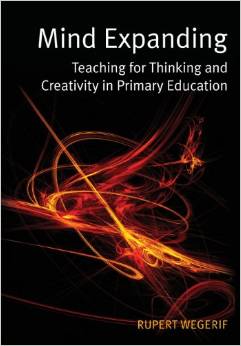
Wegerif, R (2010) Mind-Expanding: Teaching for Thinking and Creativity. Buckingham, UK: Open University Press/mcgraw Hill
"An essential addition...Wegerif zooms in on the most important ingredient of all in a learning-to-learn classroom culture - the kinds of talk that are allowed and encouraged - and brings together both scholarly and practical approaches in a highly fruitful and accessible way."
Guy Claxton, author of Building Learning Power, What's the Point of School? and New Kinds of Smart'This is a thought-provoking and readable book, which makes a very good case for the importance of teaching thinking skills and encouraging creativity through dialogue.'
Professor Neil Mercer, University of Cambridge, UK, author of Words and Minds and Dialogue and Development
There is growing interest in developing flexible thinking and learning skills in the primary classroom but there has been little agreement as to exactly what these skills are and how best to teach for them.
This innovative book responds to that challenge with a coherent account of what thinking and creativity are and how they can be taught. Taking a 'dialogic' approach, it shows how engaging children in real dialogue is possible in every area of the curriculum and how this can lead to more reflective, considerate and creative children who are able to think for themselves and to learn creatively.
Wegerif explores the success of approaches such as Philosophy for Children, Thinking Together, Dialogic Teaching and Building Learning Power. Using illustrations and activities, he explains how teaching and learning across the primary curriculum can be transformed.
This book is important reading for all primary teachers and trainees who are looking for practical ideas for teaching thinking. It will also be valuable for anyone who wants to understand education and think more about what is most important in education.
"An essential addition...Wegerif zooms in on the most important ingredient of all in a learning-to-learn classroom culture - the kinds of talk that are allowed and encouraged - and brings together both scholarly and practical approaches in a highly fruitful and accessible way."
Guy Claxton, author of Building Learning Power, What's the Point of School? and New Kinds of Smart'This is a thought-provoking and readable book, which makes a very good case for the importance of teaching thinking skills and encouraging creativity through dialogue.'
Professor Neil Mercer, University of Cambridge, UK, author of Words and Minds and Dialogue and Development
There is growing interest in developing flexible thinking and learning skills in the primary classroom but there has been little agreement as to exactly what these skills are and how best to teach for them.
This innovative book responds to that challenge with a coherent account of what thinking and creativity are and how they can be taught. Taking a 'dialogic' approach, it shows how engaging children in real dialogue is possible in every area of the curriculum and how this can lead to more reflective, considerate and creative children who are able to think for themselves and to learn creatively.
Wegerif explores the success of approaches such as Philosophy for Children, Thinking Together, Dialogic Teaching and Building Learning Power. Using illustrations and activities, he explains how teaching and learning across the primary curriculum can be transformed.
This book is important reading for all primary teachers and trainees who are looking for practical ideas for teaching thinking. It will also be valuable for anyone who wants to understand education and think more about what is most important in education.
Dialogic Education and Technology: Expanding the Space of Learning (Computer-Supported Collaborative Learning Series)
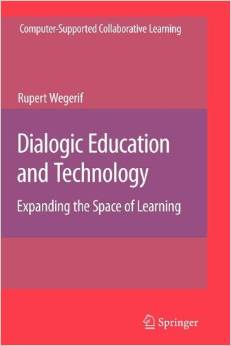
Wegerif. R. (2007) Dialogic, Education and Technology: Expanding the Space of Learning. New York: Springer-Verlag.
This book empowers people to go beyond themselves into new spheres of learning, thinking and creativity. Drawing on recent work in communications theory as well as psychology, computer science and philosophy, it reveals some key characteristics of learning dialogues. It also demonstrates ways in which computers and networks can deepen, enrich and expand such dialogues. The book's central argument is that this dialogic perspective in education and the latest developments in information and communications technology make ideal partners.
This book empowers people to go beyond themselves into new spheres of learning, thinking and creativity. Drawing on recent work in communications theory as well as psychology, computer science and philosophy, it reveals some key characteristics of learning dialogues. It also demonstrates ways in which computers and networks can deepen, enrich and expand such dialogues. The book's central argument is that this dialogic perspective in education and the latest developments in information and communications technology make ideal partners.
Radical Encouragement: Creating Cultures for Learning
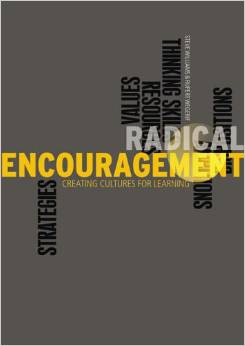
Williams, S and Wegerif, R. (2005) Radical Encouragement: Changing cultures of thinking. Birmingham: Imaginative Minds. ISBN 1904806031
Based on an independent organisation working with teachers, learners, parents, and community groups. This book is for education professionals involved in creating positive cultures for learning in schools and communities.
Based on an independent organisation working with teachers, learners, parents, and community groups. This book is for education professionals involved in creating positive cultures for learning in schools and communities.
Wegerif, R. And Dawes, L. (2004) Thinking and learning with ICT: raising achievement in primary classrooms. London: Routledge.
Primary teachers need to incorporate the use of computers in their daily lesson plans, but how can this be done most effectively to promote learning skills in the classroom? In this fascinating book, Lyn Dawes and Rupert Wegerif outline a strategy for enhancing the effectiveness of computers for teaching and learning with an emphasis on:
* raising pupil achievement in the core subject areas
* developing collaborative learning in small groups
* using group discussions as a way of improving general communication, as well as thinking and reasoning skills.
The approach is to use computers as a support for collaborative learning in small groups and this book presents ways to prepare pupils for talking, learning and thinking together around computers.
Excerpts from pupils' discussions illustrate the main issues and guidance on lesson planning and developing and choosing appropriate software is also provided. Thinking and Learning with ICT will be a valuable resource for primary teachers and student teachers.
Primary teachers need to incorporate the use of computers in their daily lesson plans, but how can this be done most effectively to promote learning skills in the classroom? In this fascinating book, Lyn Dawes and Rupert Wegerif outline a strategy for enhancing the effectiveness of computers for teaching and learning with an emphasis on:
* raising pupil achievement in the core subject areas
* developing collaborative learning in small groups
* using group discussions as a way of improving general communication, as well as thinking and reasoning skills.
The approach is to use computers as a support for collaborative learning in small groups and this book presents ways to prepare pupils for talking, learning and thinking together around computers.
Excerpts from pupils' discussions illustrate the main issues and guidance on lesson planning and developing and choosing appropriate software is also provided. Thinking and Learning with ICT will be a valuable resource for primary teachers and student teachers.
Thinking Together: A Programme of Activities for Developing Speaking, Listening and Thinking Skills for Children Aged 8-11
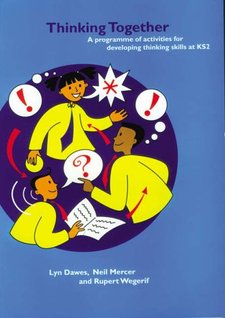
Dawes, L., Mercer, N. And Wegerif, R. (2004 2nd Edition) Thinking Together: A programme of activities for developing speaking, listening and thinking skills for children aged 8-11. Birmingham: Imaginative Minds Ltd. 124 pages (A4). ISBN 1-904806-01-5
This title presents a programme of activities for developing speaking, listening and thinking skills for children aged 8-11 (Second Edition). In today's full curriculum, there is only so much time teachers can devote to the development of language and reasoning skills. Thinking Together has been specifically designed to develop the language and reasoning skills of children at Key Stage 2. This invaluable book includes activities which have relevance to English, mathematics, science and citizenship. A key element of the Thinking Together approach is exploratory talk, which can help children improve their critical thinking and reasoning.
This title presents a programme of activities for developing speaking, listening and thinking skills for children aged 8-11 (Second Edition). In today's full curriculum, there is only so much time teachers can devote to the development of language and reasoning skills. Thinking Together has been specifically designed to develop the language and reasoning skills of children at Key Stage 2. This invaluable book includes activities which have relevance to English, mathematics, science and citizenship. A key element of the Thinking Together approach is exploratory talk, which can help children improve their critical thinking and reasoning.
Computers and Talk in the Primary Classroom (Language and Education Library)
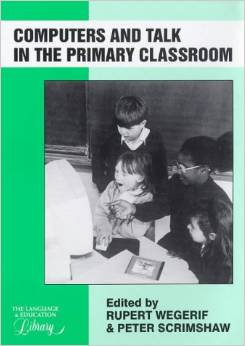
Wegerif, R. And Scrimshaw, P. (Eds) (1997) Computers and Talk in the Primary Classroom. Clevedon: Multilingual Matters. 263 pages. ISBN No. 1 85359 391 5. [5 chapters by me – much of my thesis]
This text looks at how computers are being used in primary classrooms and how they could be used better. Its three sections focus upon: how do we investigate learning through talk around computers? What affects the quality of group work around computers? What can teachers do to improve this?
This text looks at how computers are being used in primary classrooms and how they could be used better. Its three sections focus upon: how do we investigate learning through talk around computers? What affects the quality of group work around computers? What can teachers do to improve this?
Wegerif (2002) Thinking skills, technology and learning: a review of the literature for NESTA futurelab (www.nestafuturelab.org) 50 pages ISBN 0-9544695-2-6
|
